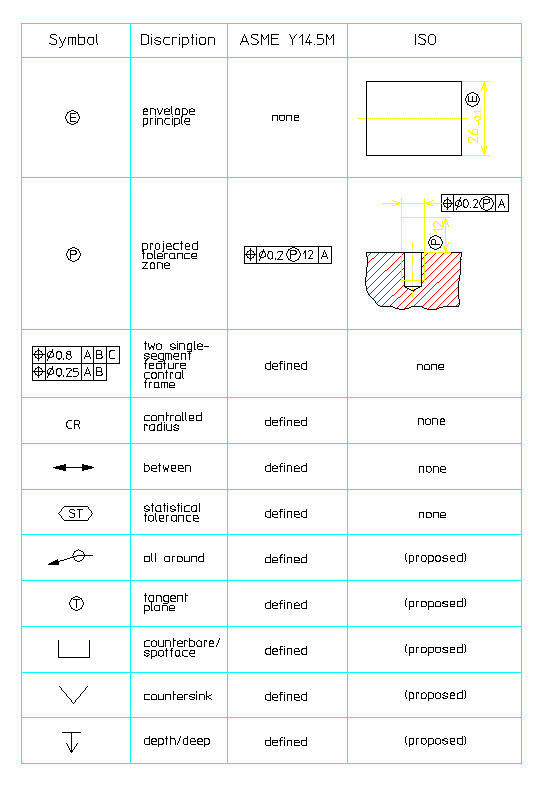Creo Elements/Direct Modeling GD&T![]()
Note: this appendix is intended to summarize some of the differences between the Y14.5 and ISO practices. For more in depth clarification or for topics not found, please refer to the respective standards.
ASME Y14.5M-1994 is a revision of ANSI Y14.5M-1982, which was approved as an ASME (The American Society of Mechanical Engineers) Standard as well as an American National Standard a few years ago. Significant steps are taken in this revision to resolve some long-standing differences between ANSI (the American National Standards Institute) and ISO (the International Orgnization for Standardization) practices. So nowadays we can say that the two standard systems are working in a very simular way in the GD&T field. But the differences still exist. Regarding the GD&T symbolic definition, following defferences between the two standard systems are recognized:
ASME Y14.5M-1994 continues to use the "envelope principle" for geometrical tolerancing, while ISO uses the "independentcy principle". ISO allows, nevertheless, the option of the envelope principle by either reference to a national standard (for example, ASME Y14.5M-1994, DIN 7167), or by invoking the symbol (E) (a "E" with a circle around it) after a dimension value. That doesn't make sense for ASME Y14.5M-1994, so the symbol (E) is not defined there.
Both in the ASME and in the ISO standard, the projected tolerance zone symbol (P) (a "P" with a circle around it) is placed in the feature control frame. But in the ASME standard the projected tolerance zone symbol is followed by a dimension value, which indicates the minimum height of the tolerance zone, in ISO standard this minimum height of the tolerance zone is dimensioned at the geometrical element directly (see the example in the table attached below).
The composite positional tolerancing concept is expanded in ASME Y14.5M-1994. It distinguishes between the "composite feature control frame" and the "two single-segment feature control frame" (the table attached below shows how the "two single-segment feature control frame" looks like). The "two single-segment feature control frame" is not defined in ISO.
There are some symbols which are only used in ASME Y14.5M-1994, not in the ISO standards. They are put together in the following attached table. The following table gives also a summary of all the differences between the ASME and ISO standard for GD&T symbols mentioned above.
Table: Differences between ASME Y14.5M-1994 and ISO standards in GD&T symbols.
